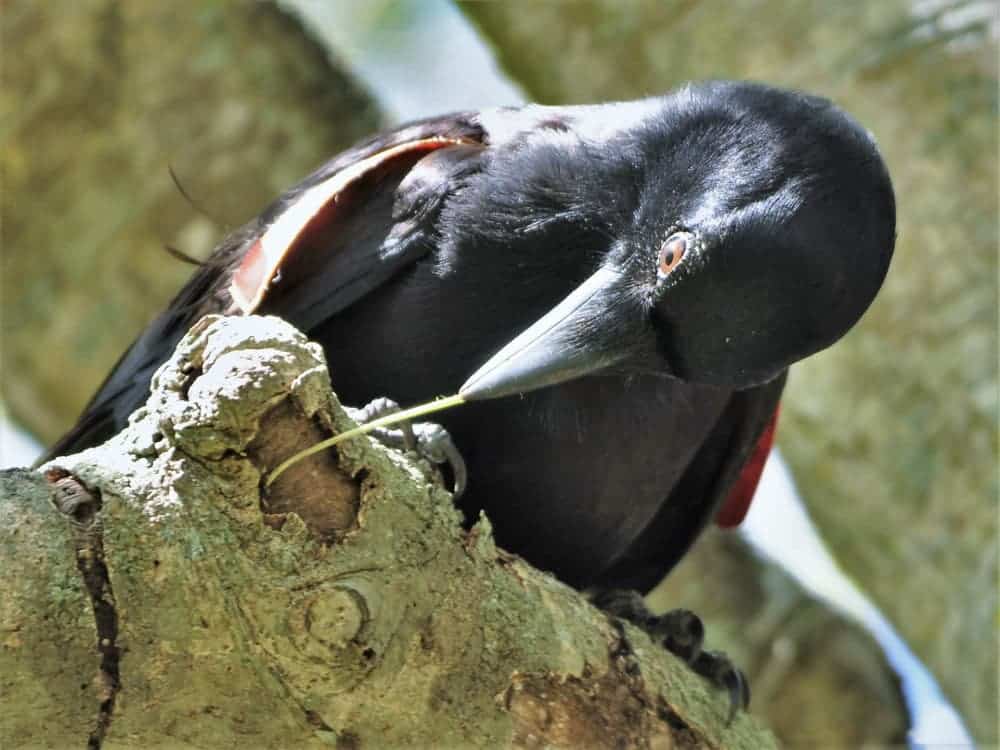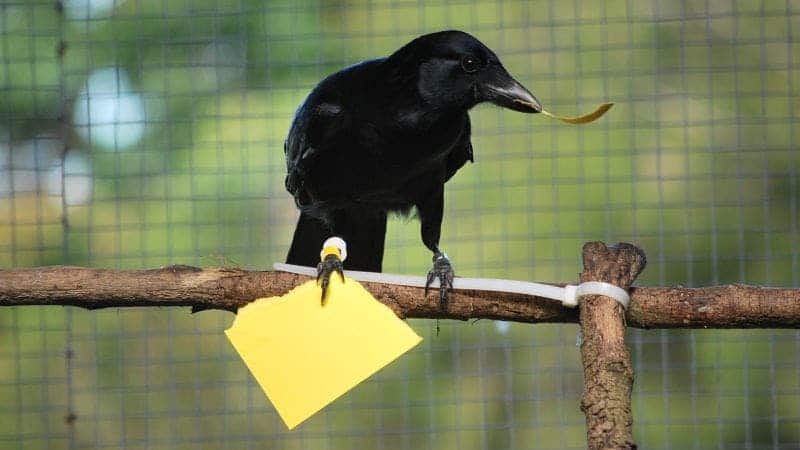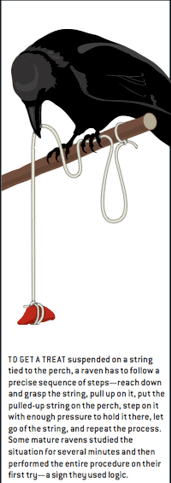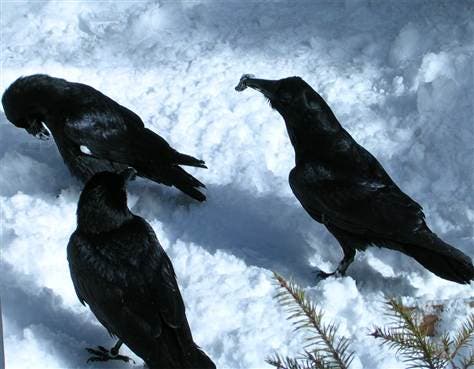Humans often like to relish the fact that they’re the most intelligent creatures in the animal kingdom. Sure, a generous brain-to-body-mass ratio can be a nice ego boost, but let’s not kid ourselves. After all, there are birds that act more reasonably and in cleverer ways than some humans whom I know personally. That may sound like an exaggeration, but wait until you learn what corvids, particularly crows and ravens, are capable of pulling off.
Crows and ravens may look very similar to the untrained eye, but their appearance and behavior clearly distinguish them from one another once you know where to look.
Compared to ravens, crows are less shiny and smaller. Crows also prefer to live in densely human-populated areas like urban landscapes, whereas ravens would much rather forage in wilder areas. However, if you really want to tell the two apart look at the bill and tail. Crows have smaller and flat bills, while those of ravens are bigger, more powerful and curved. Crow tails are fan-shaped while ravens have wedge-shaped ones.
Both birds are extremely intelligent for their body size, though, and extremely resourceful given they can only count on their bills to manipulate objects and the world around them. Yup, it’s easy to do smart things when you have opposable thumbs.
1. Crows and ravens use tools, but also make their own tools, sometimes using other tools they manufactured earlier

You can tell right away that a species is capable of complex cognitive abilities when it uses tools. Corvids not only know how to employ tools, but they also make their own.
Scottish researchers at the University of St Andrews observed New Caledonian crows — birds which live on the remote tropical island of New Caledonia in the South Pacific — fashioning hooked twigs to stir beetles from their holes.
“It’s a painstaking sequence of behaviours,” explains lead author Dr. James St Clair, from the School of Biology, University of St Andrews. “Crows seek out particular plant species, harvest a forked twig, and then – firmly holding it underfoot – carve, nibble and peel its tip, until it has a neat little hook.”
According to Clair and colleagues, hooked tools yield between 2 and 10 times more food than a straight twig. That’s a huge difference, and the crows likely recognized the improved yield.
In another mind-boggling example, researchers have witnessed not one, but two crows inserting sticks into objects to allow for easier transport. Some of these objects were too cumbersome to carry by beak alone, which is telling of the birds’ ingenuity.
Researchers at Lund University in Sweden witnessed two crows inserting sticks into objects that were too cumbersome to lift by beak alone. During four instances, the crows slipped a wooden stick inside a metal nut or into the hole of a large wooden ball. In all instances, both stick (carrying tool) and the hooked objects were flown away by the crows, the researchers reported in the journal Animal Cognition.
In a 2002 study, researchers followed a captive New Caledonian crow called Betty that took a piece of wire, bent it into a hook, then retrieved some food that was otherwise out of reach. Betty used the wire after another crow had taken all the available hooks.
Alex Taylor, a researcher at the University of Auckland in New Zealand, believes that the birds are using a sort of “mental template matching,” forming a mental picture of the tool-making process they’d seen in another bird, then copying it.
This is quite akin to how humans learn and pass on new skills between one another — through cultural transmission.
“Under the mental template matching hypothesis, New Caledonian crow tool designs could be passed on to subsequent generations if an individual used or observed the products of tool manufacture (such as their parents’ tools), formed a mental template of this type of tool design (a mental representation of some or all of the tool’s properties), and then reproduced this template in their own manufacture,” Taylor and colleagues wrote in a study published Scientific Reports.

During one logic test, ravens had to reach a hanging piece of food by pulling up a string, anchoring it with its claw, and repeating until the food was within reach. Many ravens got the food on the first try, some within 30 seconds. In the wild, ravens have been seen pushing rocks towards people to keep them from climbing to their nests, stealing fish by pulling a fisherman’s line out of holes in the ice, imitating wolves in order to attract them, and playing dead beside a beaver carcass to scare other ravens away from a delicious feast.

2. Crows remember and respond to people’s faces (and can hold a grudge)
Most birds or animals scatter when a human is approaching no matter what. However, crows only fly away when people are actually heading their away, as opposed to just strolling past them. But there’s much more to it than meets the eye.
A study published in the journal Ethology, led by Barbara Clucas of Humboldt State University, revealed new dimensions in the crow’s social reasoning. Namely, the researchers found that crows can recognize, respond and adapt their behavior to specific human faces.
In one of their experiments, the researchers separated into two groups, each wearing a different type of mask. One of the groups would trap crows in the park, while the other would just pass crows by.
Five years later, the researchers returned to the park with their mask on. Lo and behold, birds present at the original trapping events remembered which masks corresponded to being captured—and they passed this information to their young and other crows. All the crows responded to the sight of a researcher wearing a trapping mask by immediately mobbing the individual and shrieking.
“It’s one thing to learn from one’s own experience and another to observe that happening to other individuals and infer it could happen to you,” John Marzluff of the University of Washington, a co-author of the paper explained.
Seeing crows communicate abstract information and symbols (the particular type of mask associated with trapping) to other crows that did not have first hand, affective information is truly impressive.
When the crows viewed human faces that they associated with threat or care, the birds had increased activity in the amygdala, thalamus, and brain stem—areas related to emotional processing and fear learning. In response to threatening faces, areas that regulate perception, attention, and fleeing also lit up. That’s quite similar to how humans process faces in the brain.
Interestingly, jackdaws, which are crow relatives, can distinguish between friendly and dangerous people. This suggests that recognizing human faces may be a feature of corvids.
Corvids don’t just hold grudges, though. Researchers found that when they behaved fairly with crows, the birds would bring back shiny objects as a token of gratitude for being nice to them.
3. Ravens use gestures to point out things and communicate

In a 2011 study, German and Austrian researchers described how ravens would use their beaks in the same manner a human might use their hands to point out objects such as moss, stones, and twigs.
Besides gesturing, the ravens also interacted with their peers using various objects, touching or clasping their bills together, or by manipulating the item together.
“Most exciting is how a species, which does not represent the prototype of a ‘gesturer’ because it has wings instead of hands, a strong beak and can fly, makes use of very sophisticated nonvocal signals,” Simone Pika of the Max Planck Institute for Ornithology in Munich, Germany told LiveScience.
Pika believes that ravens could offer a unique glimpse into the origin of gestures in humans.
“Gesture studies have too long focused on communicative skills of primates only. The mystery of the origins of human language, however, can only be solved if we look at the bigger picture and also consider the complexity of the communication systems of other animal groups,” the researcher said.
4. Crows understand water displacement better than some children
In Aesop’s famous fable, The Crow and the Pitcher, a thirsty crow finds a pitcher with a bit of water left in the bottom. Alas, the bird’s beak isn’t long enough to reach it. But the clever crow is steadfast and drops stones into the pitcher until the water comes to it.
Turns out this is no fiction. A 2014 study showed that crows understand water displacement at the level of a 5- to 7-year-old-child. For instance, when researchers put pieces of meat floating in a long narrow glass, the crows figured out that they could add objects to the container to raise the water level and bring the treat to them. You can see them in action in the video below.
5. Ravens can tell when people are spying on them (and can get paranoid)
When people suspect they’re being watched, they tend to be very self-conscious. And if they don’t want to be seen, they will minimize their movements. This level of abstraction was thought to be unique to humans, but a 2014 study published in Nature Communications showed the ravens are also aware when they’re being spied upon.
During one experiment, ravens were placed in adjacent tiny rooms, separated by a window. Initially, the window was left uncovered so each raven could see where its neighbor was hiding food. Later, the window was covered, leaving only a small peephole, which the ravens quickly learned they could use to see but also be seen through.
The researchers played an audible track from one of the cages which sounded like a raven was in the process of hiding food (scratching, pecking, dirt being displaced). Only when the peephole was left uncovered did the neighboring raven bother to take extra care in hiding its food. The bird hurried to hide the food and once the audio track stopped playing, the raven returned to the hiding spot to improve the concealment. If the peephole was closed the raven was careless, suggesting it understood that no one could track its actions.
6. Crows can solve highly complex puzzles
BBC Two journalists put corvid intelligence to the ultimate test by setting up the most complex animal puzzle ever. Captured wild crows completed eight individual steps, which they had to solve in a specific order, to gain access to a food reward. To do so, the crows had to collect tools and interact with puzzles to move to the next step. Watch the video of the experiment — it’s crazy good.
7. Crows hitch rides on eagles
Wildlife photographer Phoo Chan caught the shot of a lifetime: a crow riding atop a bald eagle. Although the scene only lasted for a few seconds, it speaks volumes about crows’ fearsomeness, even when faced with a much larger predator.
It might not be the smartest move, but it sure is freaking amazing.
[no_toc]


